The first metal of South America (part of 1)
Plateau Machu Picchu
at the very threshold of heaven
were full of songs, oil,
man destroyed nesting
huge birds on the tops
and in their new possessions
the farmer kept the seeds
in the fingers, injured by the snow.
Pablo Neruda. Universal Song (translated by M. Zenkevich)
Some time ago on the pages of "VO" three materials were published under the general title "Destructive and Fertile Bronze" (Bronze Age Culture - 1, 2, 3), as well as a number of additional materials about the Trialeti Cup, finds from the Bronze Age in Denmark and in Crete. In a word, today we can say that Europe is finished with the Bronze Age. It was about seimintsy and turbinians, there was a puddle culture, there was a Borodino treasure, a reenactor Nile Barridge - it was. There was also an impressive selection of materials on the soldiers of the Trojan War, which also belonged to the Bronze Age. But in the New World it was only that a rather brief story about the forging of copper in the cold by the tribes living along the Great Lakes, and the Yellowflowers tribe. It was concluded that the term Bronze Age is not applicable to the culture of North America, because the cultures that existed there and who owned the metalworking technology remained in the copper-stone age. Most of the other lucky Aztec and Maya, who have learned to mine and process gold and silver. However, they could not master the technology of smelting bronze. True, single finds of bronze objects in the west of Mexico are known to archaeologists, but it is believed that they are not of local origin. In general, the term “Bronze Age” does not apply to the cultures of Mesoamerica. However, it cannot be said that America did not know the Bronze Age. In the Bronze Age lived the Incas, who lived in the mountainous regions of South America.
From the culture of the urine to our day, there are many wonderful gold items, but many of them are quite unusual. How do you, for example, here is a decoration for the nose? (Metropolitan Museum, New York)
Decoration for the nose, V - VI centuries. AD (Metropolitan Museum, New York)
However, even before appearing on historical the Inca arena there already existed a number of civilizations that knew metal. First of all, it is the civilization of Moche (or the Mochik culture, known for its original colored and stucco ceramics and perfect irrigation systems), Uari (a state that, in fact, became a prototype of the Inca empire, although its population spoke a different language), Chimu (with the center in the city of Chan-Chan, and also with characteristic ceramics and architecture), Nazca (which everyone knows about by giant figures and lines on a plateau located high in the mountains), Pukina (with the capital in the city of Tiahuanako east of Lake Titicaca), Chachapoyas ( “Warriors of the Clouds”, known for their mountain fortress of Kuelap, which is also called “Machu Picchu of the North”). They all knew metal and knew how to work with it, although if copper was already mined in Mesopotamia in 3500 BC. e., then in the Peruvian burials of the product from it first occurs only after 2000 BC. e. And archaeological finds clearly indicate that when the Incas finally appeared here and created their empire, they did not bring any new technologies with them, they just organized ore mining and started smelting metal on a large scale.
Also a decoration for the nose, but quite simple. Apparently the author was an esthete or "had neither mind nor imagination." But gold! This is already something! (Metropolitan Museum, New York)
The golden nasal decoration inlaid with turquoise and chrysocolla clearly belonged to a person with taste or position. Moche culture (200 — 850 years AD.). (Metropolitan Museum, New York)
Well, the beginning of the metalworking in South America was laid by the ancient culture of Urine, about the origin of which we can say little, except that it ... really was, because there were numerous artifacts from it! It arose on the eve of our era, and existed until the VII century, and reached its highest peak in the III - VI centuries. The economic basis of this culture was the development of irrigated agriculture, based on the use of natural fertilizers, such as guano, which the Moray Indians used to mine on islands located near the coast. Using such a primitive work tool, like a hardwood digging stick made of copper, which only occasionally had a copper tip, they achieved impressive successes in plant growing and gardening. And they also bred llamas, which gave them wool, and guinea pigs ... for meat! Naturally, living on the shores of the ocean, they fished and engaged in sea fishing.
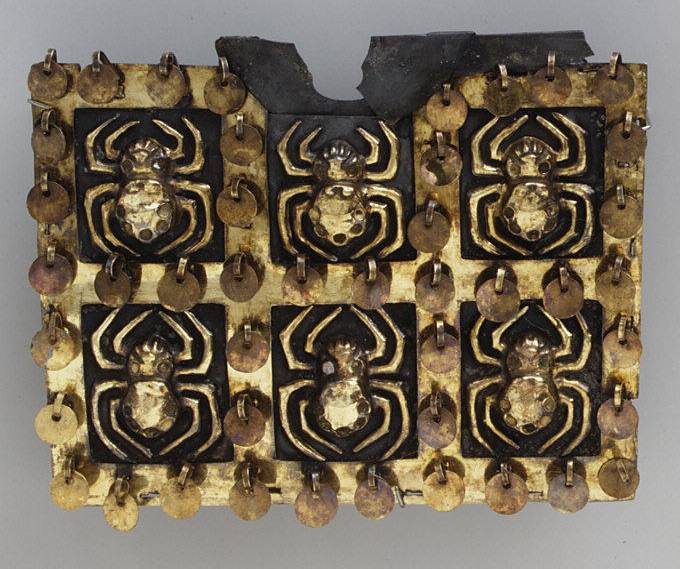
But how did they wear this in the nose? (Metropolitan Museum, New York)
But the most important thing in this case is that the creators of the Mochica culture were excellent metallurgists and skilled jewelers. Already in the II. AD they knew how to smelt copper, and alloy it with gold and silver. They knew casting wax casting and gilding products by etching. The Urea metal was also used to make jewelery and luxury goods, as well as for tools.
Golden mask sipanskogo culture. (Metropolitan Museum, New York)
Pottery has also been very developed. And the ritual colored vessels and portrait vessels, depicted as scientists by very specific people, were especially successful in the Mochika Indians. The molding in their manufacture was combined with artistic painting, and the vessels themselves (or their individual elements) were often printed in forms, which allowed them to be replicated many times. True, they did not know the potter's wheel, but such a technological device completely replaced it! On some vessels, signs can be found that may well be regarded as peculiar marks of the masters, which indicates a high level of their professional skills.
Clips for the ears. Gold inlaid. Culture Urine. (Metropolitan Museum, New York)
Urica fabrics were made from cotton yarn, sometimes mixed with wool. On one of the vessels, for example, even a weaving workshop was depicted, where women worked on hand looms tied at one end to a pole or beam, and the other to a weaver's belt. Their work is supervised by someone of a higher rank.
Sipan culture mask. X – XII centuries. 74% gold, 20% silver, and 6% copper. (Metropolitan Museum, New York)
Attracts attention and construction art. The Mochica Indians erected an enormous (55 m high) stepped pyramid of Huaca-Fortalez. Two more pyramids built in the Moche Valley were smaller: Huaca del Sol (approximately 40 m) and Huaca de la Luna (more than 20 m). But these were centers where the pyramids were combined with urban buildings, and there were also separate pyramids and real fortresses.
Portrait vessel belonging to the Moche culture. (Metropolitan Museum, New York)
Interestingly, as the material from which all this was constructed, were rectangular raw bricks - adobe. Moreover, on the bricks of which large pyramids were laid in the valley of the Moche, geometric imprints were found, which today are considered to be signs of the communities, according to which they counted the number of bricks produced as labor service. The walls of buildings of a cult character were covered with frescoes of a mythological character and exactly the same images of mythical characters and characteristic scenes can be found on objects made of metal and textiles and on a huge number of ceramic products.
Bottle of Fox Warrior. Culture Urine. (Metropolitan Museum, New York)
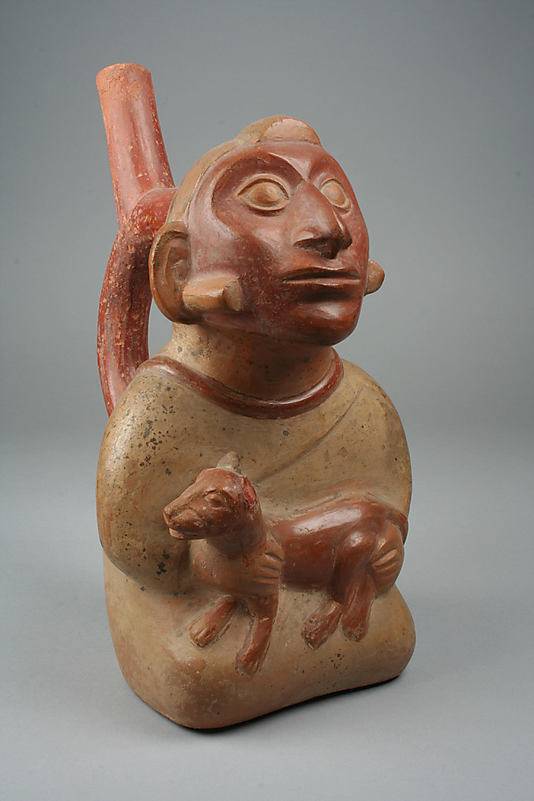
Portrait bottle, culture Urine III - VI centuries. (Metropolitan Museum, New York)
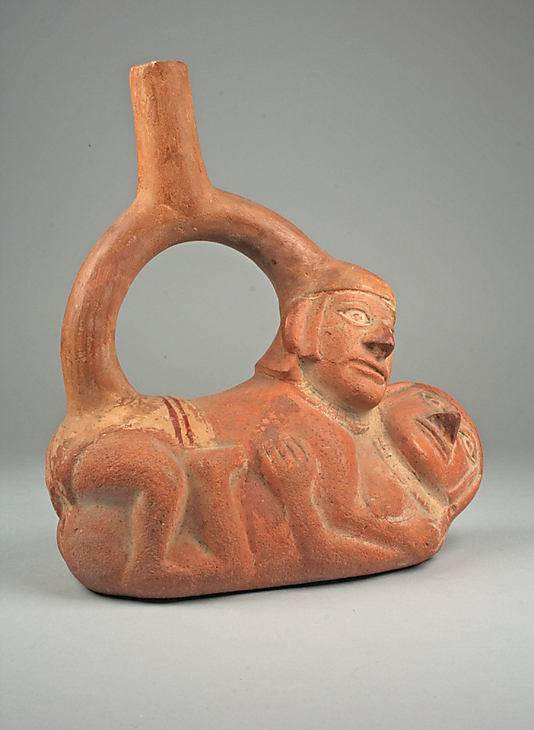
"Love". Culture Urine. (Metropolitan Museum, New York)
At the head of the pantheon of deities of the Mohican society were anthropomorphic deities and, in particular, “God with rays”. Zoomorphic, but largely human-like deities, for example, warrior gods — the fox-god, the sea-eagle god, the deer god, and others, as well as the god-priests — the god-owl god-monkey, the bat-god, and secondary deities - the Urubu vultures, cormorants, lizards, mice, etc., occupied the lower level, where phytomorphic deities were located. Totally fantastic mocha creatures were also known. These are dragons, demons, jaguars frogs.
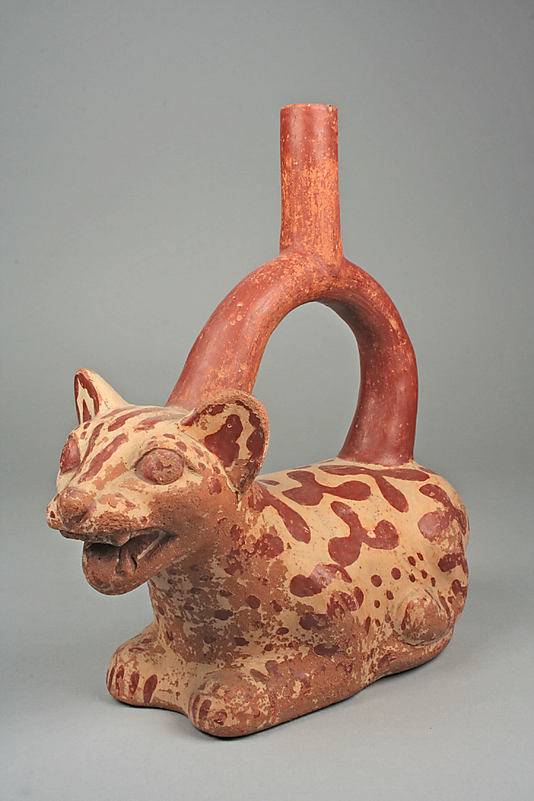
Bottle-cat. Culture Urine. (Metropolitan Museum, New York)
His deceased Moika was buried in narrow pits, with a ceiling of rods and bricks - adobe. The dead were wrapped in mats on their backs. Even in ordinary burials they find several vessels and other things. Whereas in the rich burials there are dozens! It is known, for example, the burial of an elderly “warrior-priest” in the Viru valley, who was buried in a copper mask, and he was accompanied by the remains of a child, as well as two women and a man. Together with him, a huge number of ceramic vessels, wooden rods with artfully carved inlaid top pieces, various feather items, headdresses and various other items went to the “other world”.
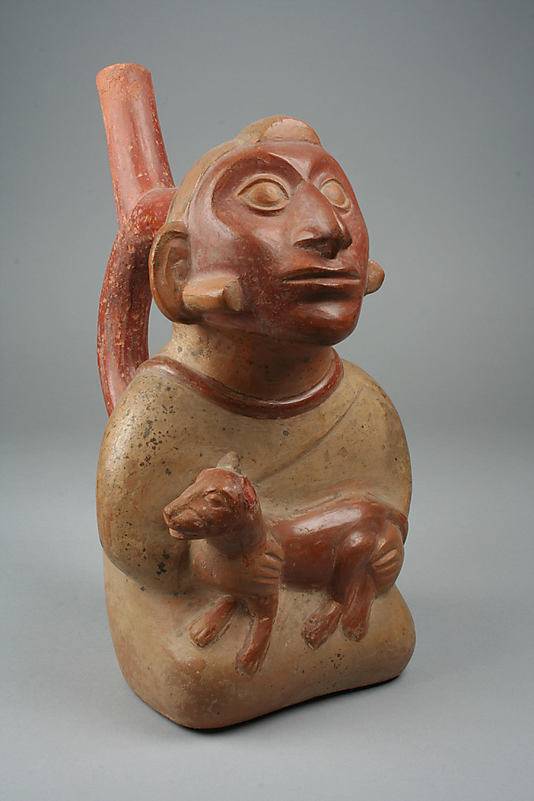
Moicha Indians loved cats and were often portrayed. For example, a vessel on which a man with a cat in his arms is shown. (Metropolitan Museum, New York)
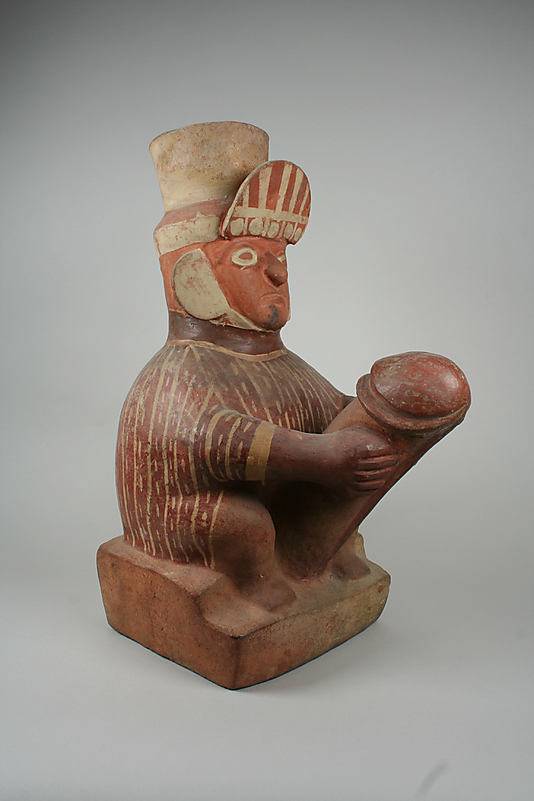
They loved such “sculptural images” ... (Metropolitan Museum, New York)
And cats were even portrayed on nose-decorations! Culture Urine. (Metropolitan Museum, New York)
On the northern outskirts of the Urica territory, in Sipan, in the thick of the raw platform on which temple buildings once stood, they found a rectangular grave in which stood a wooden coffin with the remains of a man lying on his back and holding something like a golden scepter in his hands. A golden mask covered his lower face, his body was wrapped in cloth. A huge amount of things (more than 400!) Were found in the grave, which denoted its high rank - headgear, gold jewelry with inlays, feather jewelry, precious shells, gold and bronze plates that served as an armor, gold standards and much more. The deceased was accompanied by eight people.
The excavated tomb of "Ruler Sipan."
Judging by their clothes and remains, they were his wife, the other two women — probably concubines, a warlord, a guard, a standard-bearer, and a child. Among the animals found was a dog, as well as countless ceramic vessels of various shapes and purposes. Below his grave was the grave of his predecessor, where he also found the remains of a young woman and a lama, as well as luxurious clothes decorated with gold and silver. The presence of rich burials was also noted in the pyramids of the Moche Valley.
Decoration headdress, II. AD Culture of the Nazca. (Metropolitan Museum, New York)
In the VII century. Moche civilization gradually fell into decay, and at the end of VII - the beginning of the VIII century. and completely ceased to exist. However, it is important to another, namely, that the first finds of arsenic bronze products in South America just belong to this culture. That is, in the middle of I millennium n. e., in northern Peru, bronze metallurgy already existed. The cultures of Tiwanaku and Huari that appeared after it were able to smelt classical tin bronze, that is, they improved the Moche technology. Well, and the state of the Inca Tauantinsuyu, which existed in South America in the XI - XVI centuries, can already be completely considered a civilization of the developed Bronze Age.
Bronze knife of the Incas of the XV - XVI centuries. (Metropolitan Museum, New York)
For some reason, it is believed that the main metal of the Incas was gold, but in fact they mined and processed a number of other metals. By fusing copper and tin, they received bronze, which in their society was the only metal that ordinary Indians could use to make jewelry, without which, of course, people of ancient civilizations simply could not exist.
To be continued ...
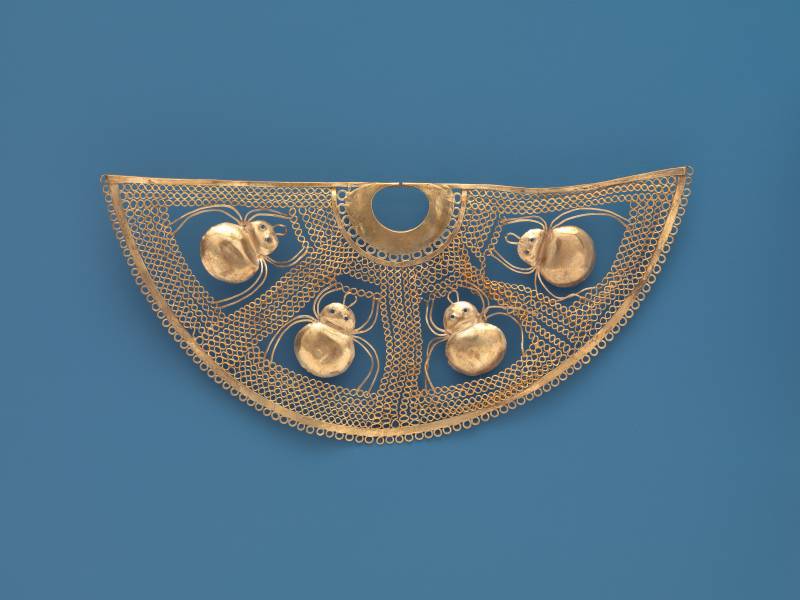
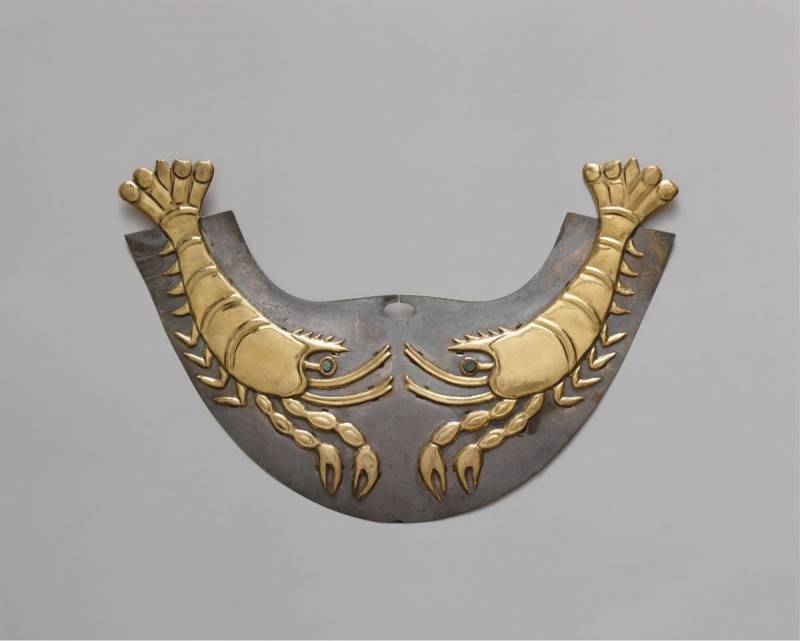
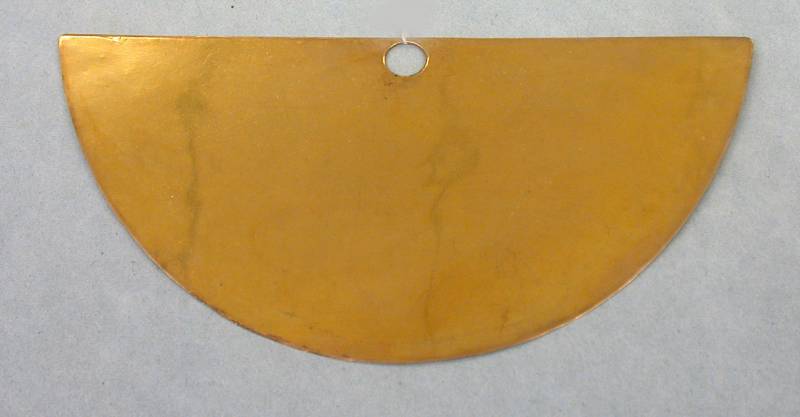
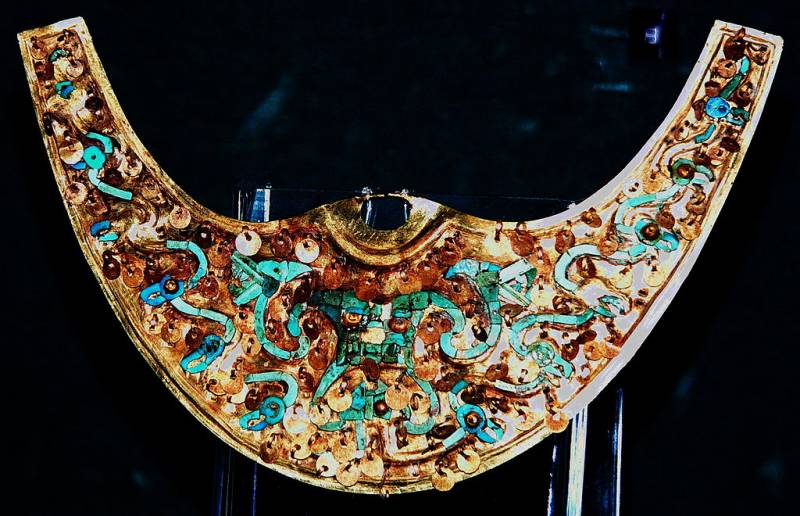
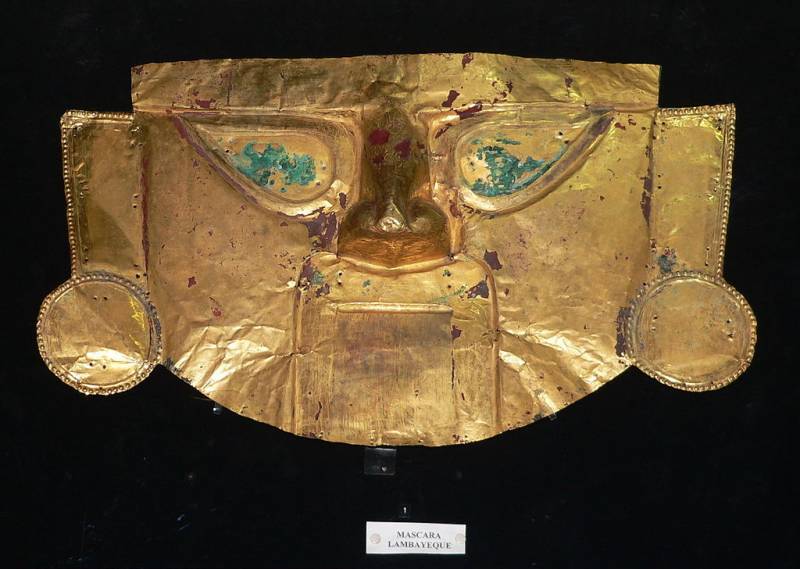
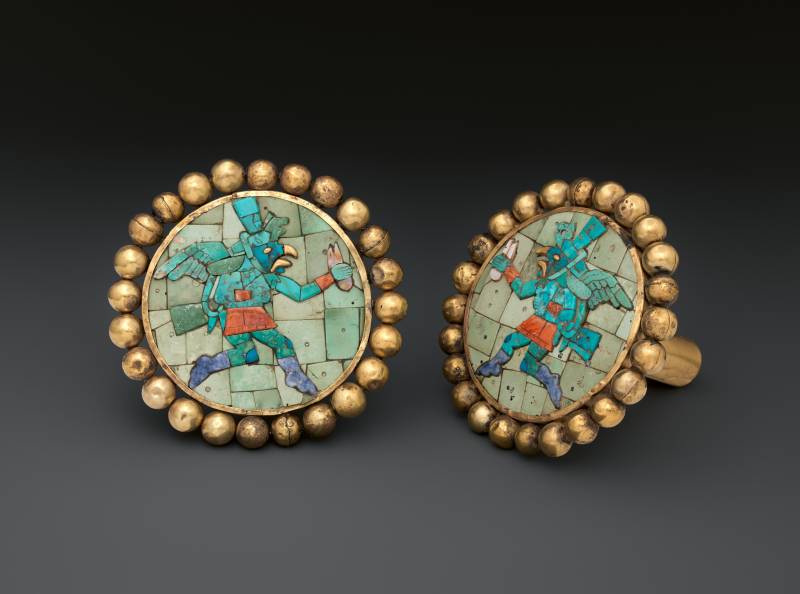
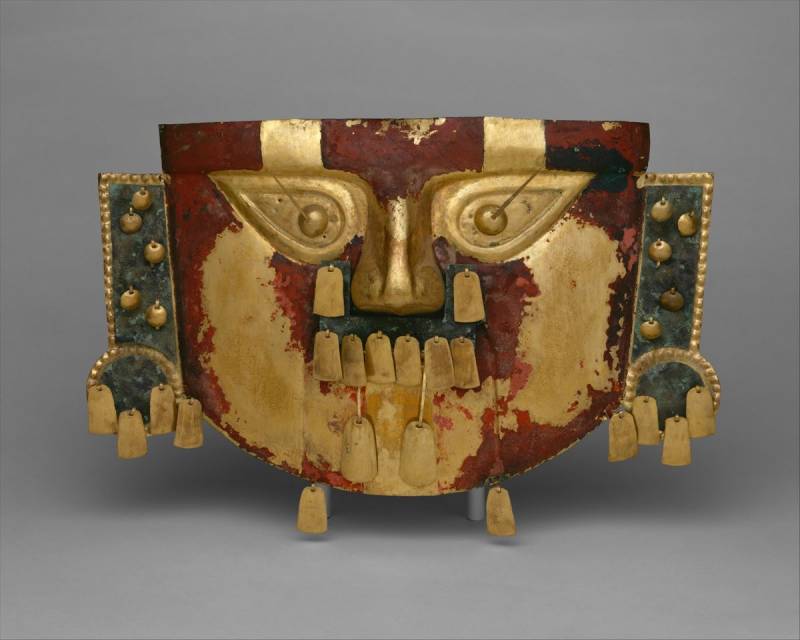
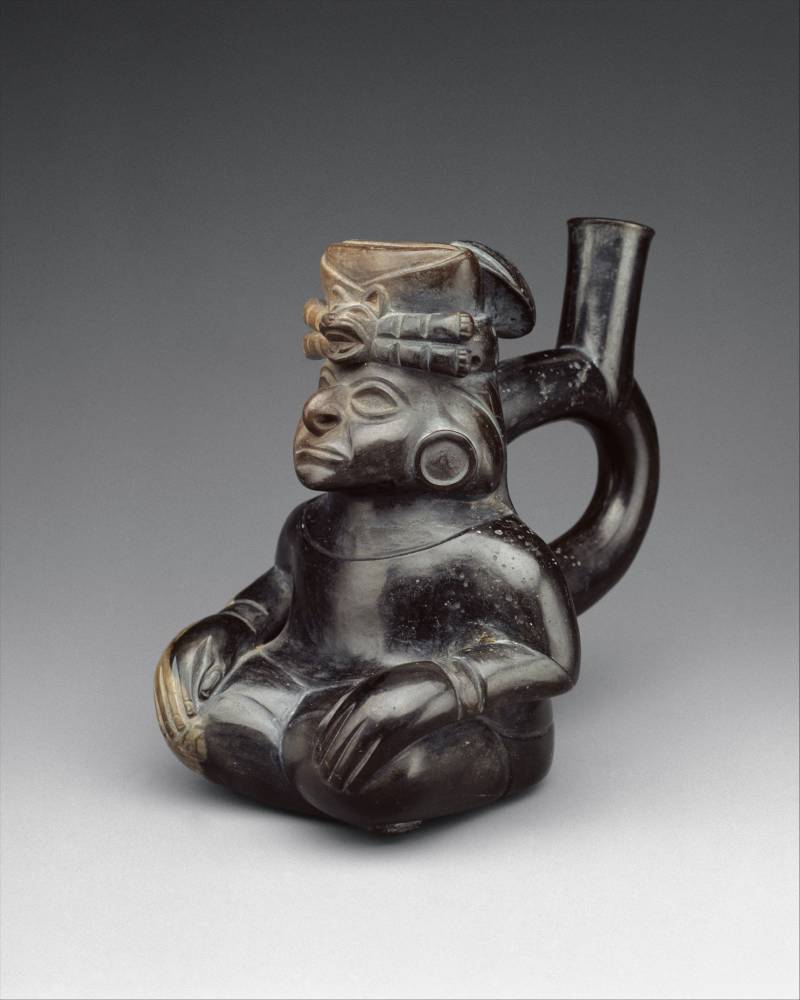
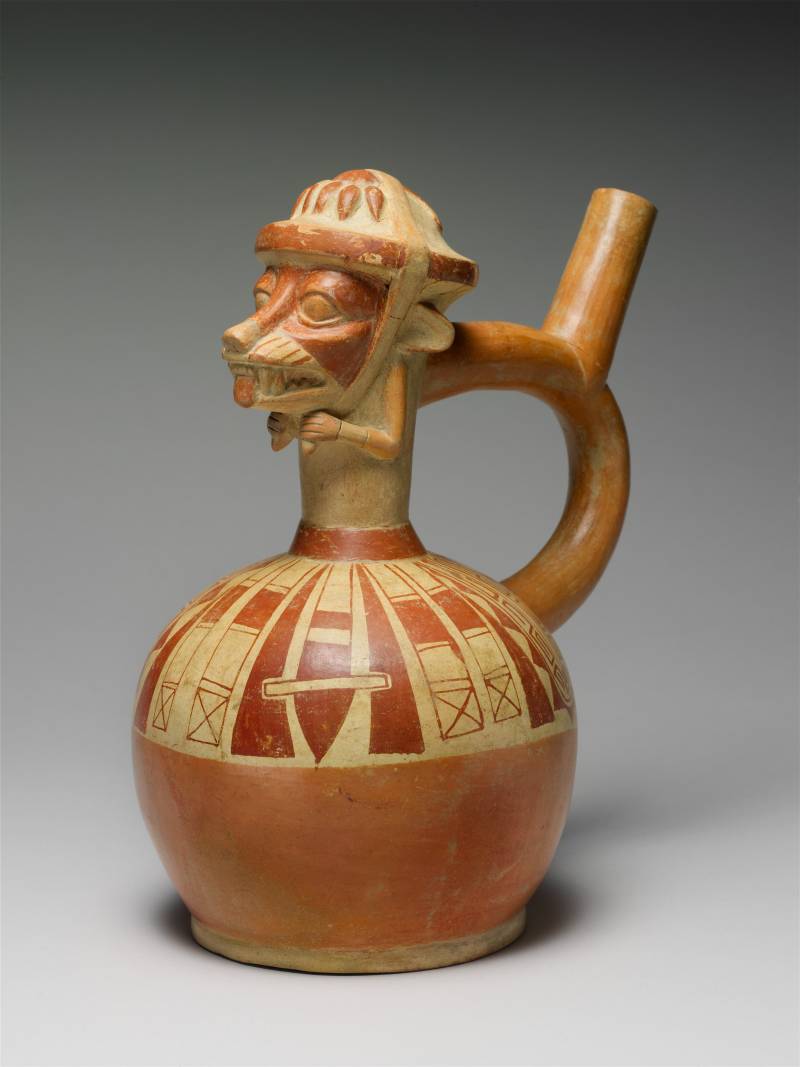
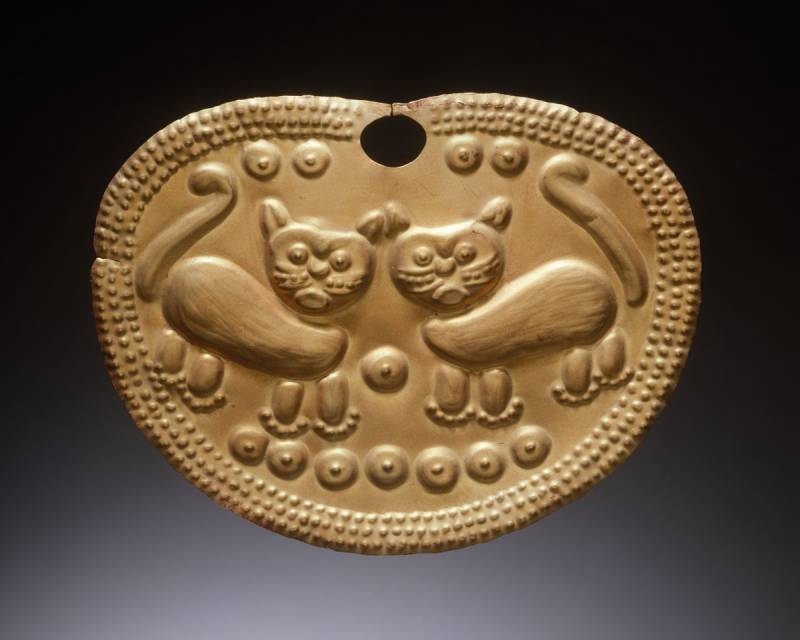
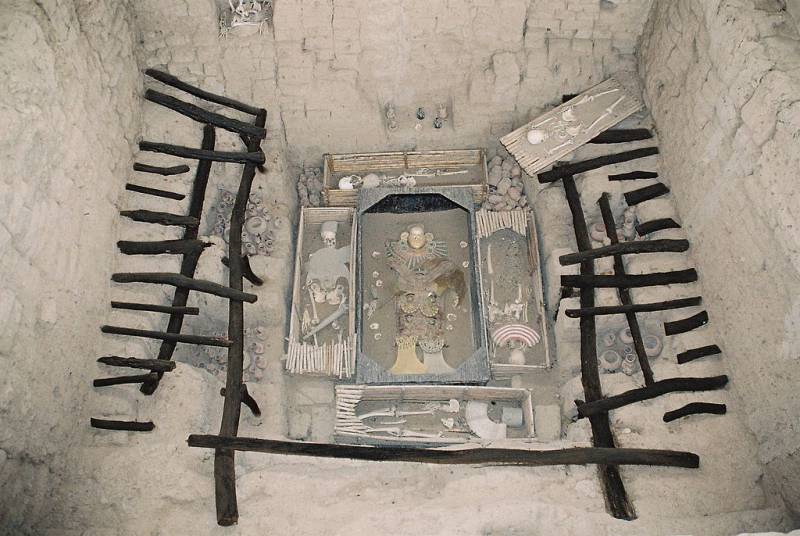
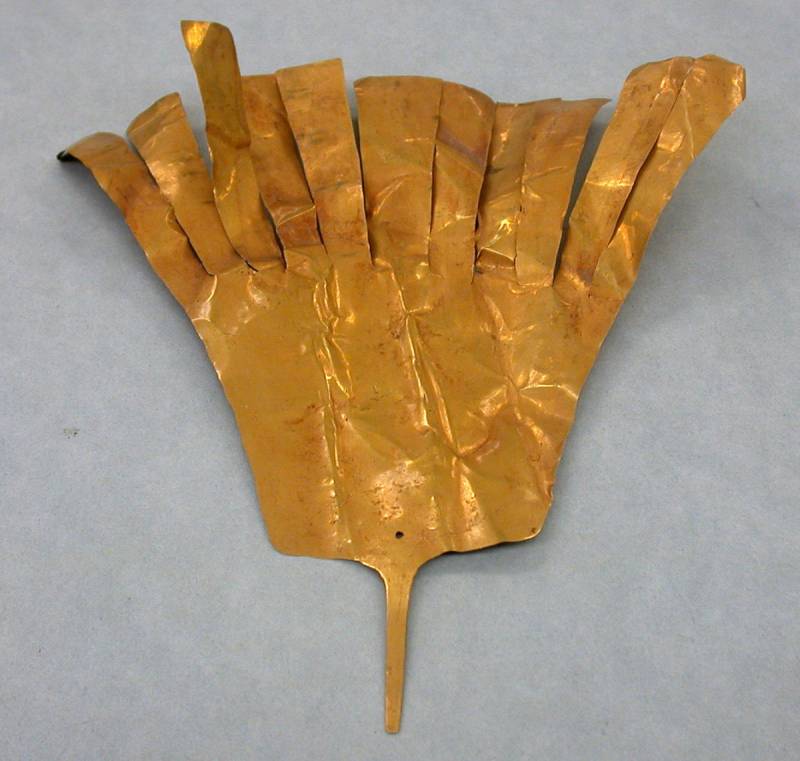
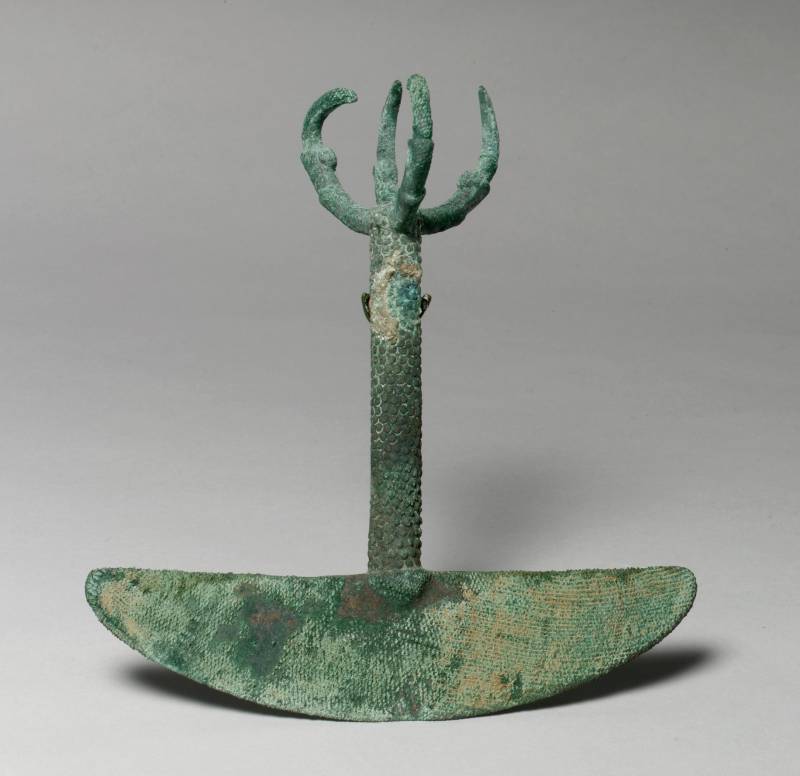
Information